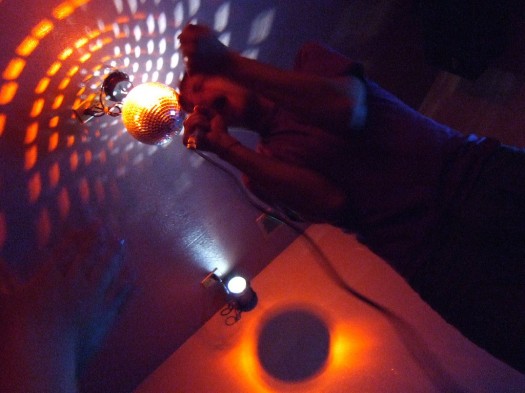We have a house guest this week, and we've been doing a lot of hanging out while reading and listening to music. Last night, the discussion turned to Auto-Tune, and it quickly revealed the beauty of being at least somewhat Internet-literate.
 Speaking of Internet-literate, this is our houseguest: Dave.
Speaking of Internet-literate, this is our houseguest: Dave.It started with Lil Wayne. I mentioned to Mara and Dave that Stereogum has an irritating post about Lil Wayne's use of Auto-Tune on SNL. It was irritating because, to me, there's a difference between using Auto-Tune to compensate for your own inability to hit the notes (e.g., Kelly Clarkson in "Since U Been Gone"), and using it to increase the funky quotient, as Lil Wayne does in "Lollipop." Anyway, Dave recalled a Pitchfork interview with Neko Case in which she has some salty words on the subject of Auto-Tune. [tappity-tappity]
Neko Case: When I hear Auto-Tune on somebody's voice, I don't take them seriously. Or you hear somebody like Alicia Keys, who I know is pretty good, and you'll hear a little bit of Auto-Tune and you're like, "You're too fucking good for that. Why would you let them do that to you? Don't you know what that means?" It's not an effect like people try to say, it's for people like Shania Twain who can't sing.
(It gets even saltier). Then the conversation turned to Auto-Tune's first major splash, which was recently discussed in a Sasha Frere-Jones piece in the New Yorker [tappity-tappity]
The first popular example of Auto-Tune's distorting effect was Cher's 1998 hit "Believe,†produced by Mark Taylor and Brian Rawling. During the first verse, Auto-Tune makes the phrase "I can't break through†wobble so much that it's hard to discern.
Of course, then we had to hear "Believe," so Dave suggested Favtape. [tappity-tappity] Bingo; briefly, we revisited 1998. Then, it seemed like it made sense to listen to Bedhead's cover as well. [tappity-tappity] It features a touch-tone phone as an instrument.So what's the story with using Auto-Tune on "Believe?" Did the producers seek it out because Cher couldn't hit the notes, or did they just want to get funky? [tappity-tappity] The Internet has your answer, sort of. It's from a 1999 article in the British magazine Sound on Sound, but the problem is that the producers don't admit to using Auto-Tune; it was still a trade secret at that point:
The … obvious vocal effect in 'Believe' is the 'telephoney' quality of Cher's vocal throughout. This idea came from the lady herself — she'd identified something similar on a Roachford record and asked Mark if he could reproduce it.He explains, "Roachford uses a restricted bandwidth, and filters the vocals heavily so that the top and bottom ends are wound off and the whole vocal is slightly distorted. It took a while to work out exactly what it was that Cher liked about this particular Roachford song, but in the end we realised it was the 'telephoney' sound. I used the filter section on my Drawmer DS404 gate on the vocal before it went into the Talker to get that effect."
Actually, we now know the truth. It was Auto-Tune. All of this happened in about 15 minutes; we explored the arc of Auto-Tune in popular songs, with examples of early incarnations and deep discussion about how and why it was applied. Nice. [tappity-tappity]




 The UX Week program with my
The UX Week program with my  Our place is the yellow two-story walk-up that is bustin out of the top of the frame. I love that it was captured on one of those semi-sunny days where little wisps of fog drift through. So nice to not live in the fog belt. Incidentally, here's the Chronicle's
Our place is the yellow two-story walk-up that is bustin out of the top of the frame. I love that it was captured on one of those semi-sunny days where little wisps of fog drift through. So nice to not live in the fog belt. Incidentally, here's the Chronicle's 